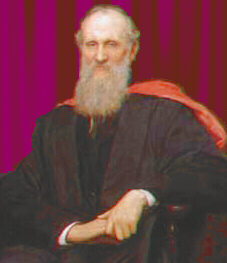
Born: 26 June 1824; Belfast, Ireland
Died: 17 Dec 1907; nr. Largs, Ayr
Education: Univ. of Glasgow then Cambridge University.
"When you can measure what you are speaking about and express it in numbers, you know something about it."
Lecture to the Institution of Civil Engineers, 3 May 1883
~ Lord Kelvin ~
He was an infant prodigy in mathematics, taught by his father until, at age 11, he entered the University of Glasgow in 1841. Guided by his father's interest in his education, Thomson went to Cambridge University in 1845 and postgraduate work in Paris with Regnault, including study of science demonstration techniques. Throughout his education, Thomson demonstrated excellence and published scholarly papers on mathematics, the first when he was 16.
When he became Professor of Natural Philosophy at Glasgow university in 1846, he held the position for half a century. He created the first physics laboratory at a British University. In the same year, he estimated the age of the earth, based on creation at the temperature of the sun, and calculating the rate of cooling for a body of the size of the earth. His estimate of around 100 million years, though, was made without knowledge of the heating effect of the radioactivity in the earth's core. He stubbornly defended this calculation throughout his life, and contested Darwin's conclusions on evolution as impossible in the time period.
 | |
Kelvin's other interests in heat, though, were productive and correct. He first defined the absolute temperature scale in 1847, which was subsequently named after him. In the same year, still in his early 20's, he was made a member of the Royal Society.
In 1851 he published ideas leading to the second law of thermodynamics and supported his friend James Joule's mechanical equivalent of heat. He changed the view of heat as being a fluid to an understanding of the energy of motion of molecules. The term "kinetic energy" was introduced by Thomson in 1856. The names of these two scientists are linked with the famous Joule-Kelvin Effect which makes refridgerators work. Kelvin's name is also immortalised by the Kelvinator fridge.
"I am never content until I have constructed a mechanical model of the subject I am studying. If I succeed in making one, I understand. Otherwise, I do not."
~ Notes of Lectures on Molecuar Dynamics and the Wave Theory of Light. ~
While at Cambridge, Thomson had published ‘The Uniform Motion of Heat in Homogeneous Solid Bodies, and its Connection with the Mathematical Theory of Electricity,’ (Cambridge Mathematical Journal, vol. iii. 1842.) By applying this analogy of heat flow to the flow of electricity, in 1854, he joined Cyrus Field's efforts to lay a transatlantic telegraph line. He improved the design of the cables, even traveled on the ships supervising the laying of them.
This experience prompted Kelvin's invention of the mirror galvanometer (patented 1858) as a long distance telegraph receiver which could detect extremely feeble signals. He studied the electrical losses in cables, and improved the mariner's work with the invention of an improved gyro-compass, new sounding equipment, and a tide prediction with chart-recording machine. He also introduced Bell's telephone into Britain.
He stayed with the transatlantic cable project despite problems, setbacks and the need to restart more than once. With the breadth experience acquired, he now became wealthy from consulting on the subsequent submarine cable projects of others.
"Do not imagine that mathematics is hard and crabbed, and repulsive to common sense. It is merely the etherialisation of common sense."
~ SP Thompson in Life of Lord Kelvin, 1910 ~
Thomson published more than 600 scientific papers and filed a total of 70 patents. He was the president of the Royal Society from 1890 to 1895.
In 1866 he was knighted because of his achievements in submarine cable laying. In 1892 he was raised to the peerage as Baron Kelvin of Largs, which title he chose from the Kelvin River, near Glasgow. He was Britain's first scientific peer.
Late in life, he resisted the new scientific revolution that was beginning, so different from the science he knew:
"Heavier-than-air flying machines are impossible." (1895)
when he died in 1907, he was buried next to Isaac Newton in Westminster Abbey.
No comments:
Post a Comment